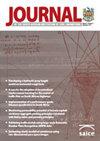考虑土-结构相互作用时,研究中高层建筑结构墙系统的行为因素和地震反应
IF 0.6
4区 工程技术
Q4 ENGINEERING, CIVIL
Journal of the South African Institution of Civil Engineering
Pub Date : 2022-07-05
DOI:10.17159/2309-8775/2022/v64no2a4
引用次数: 1
摘要
实践工程师通常遵循线性方法进行地震设计和评估,将其方法限制在SANS 10160-4 (SANS 2017)的要求中。这通常会导致一个保守的设计,留下很少的空间来应用额外的工具来改进设计。在地震作用下,土-结构相互作用对大多数建筑结构都有有利的影响。然而,在分析中纳入土-结构相互作用会影响基本周期、阻尼和延性,因此会影响设计规范规定的行为系数。行为因子对于线性方法(基于力的方法)预测结构的非线性行为是必要的。当土-结构相互作用纳入分析时,根据SANS 10160-4 (SANS 2017)的规定,本调查评估了中低层建筑中钢筋混凝土墙的当前行为因子。建筑最初使用线性方法进行设计和详细设计,并使用规定的行为因素,然后使用不需要使用行为因素的非线性方法进行测试。本文章由计算机程序翻译,如有差异,请以英文原文为准。
Investigating the behaviour factor and seismic response of structural wall systems in low- to medium-rise buildings when soil-structure interaction is considered
Practicing engineers typically follow linear methods for seismic design and assessment, confining their approach to the requirements of SANS 10160-4 (SANS 2017). This generally leads to a conservative design, leaving little space to apply additional tools for design refinement. Soil-structure interaction has beneficial effects for most building structures under seismic action. However, incorporating soil-structure interaction in the analysis influences the fundamental period, damping and ductility, and will therefore influence the behaviour factor prescribed by design codes. The behaviour factor is necessary for linear methods (force-based methods) to predict the nonlinear behaviour of the structure. This investigation assessed the current behaviour factor for reinforced concrete walls in low- to medium-rise buildings, as prescribed by SANS 10160-4 (SANS 2017), when soil-structure interaction is incorporated in the analysis. The buildings were initially designed and detailed using linear methods, with the prescribed behaviour factor, and then tested using nonlinear methods that do not require the use of a behaviour factor.
求助全文
通过发布文献求助,成功后即可免费获取论文全文。
去求助
来源期刊
CiteScore
0.70
自引率
25.00%
发文量
19
审稿时长
>12 weeks
期刊介绍:
The Journal of the South African Institution of Civil Engineering publishes peer reviewed papers on all aspects of Civil Engineering relevant to Africa. It is an open access, ISI accredited journal, providing authoritative information not only on current developments, but also – through its back issues – giving access to data on established practices and the construction of existing infrastructure. It is published quarterly and is controlled by a Journal Editorial Panel.
The forerunner of the South African Institution of Civil Engineering was established in 1903 as a learned society aiming to develop technology and to share knowledge for the development of the day. The minutes of the proceedings of the then Cape Society of Civil Engineers mainly contained technical papers presented at the Society''s meetings. Since then, and throughout its long history, during which time it has undergone several name changes, the organisation has continued to publish technical papers in its monthly publication (magazine), until 1993 when it created a separate journal for the publication of technical papers.

 求助内容:
求助内容: 应助结果提醒方式:
应助结果提醒方式:


